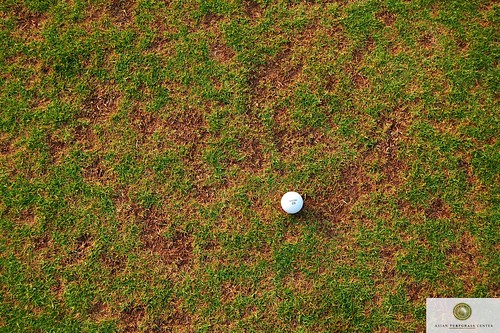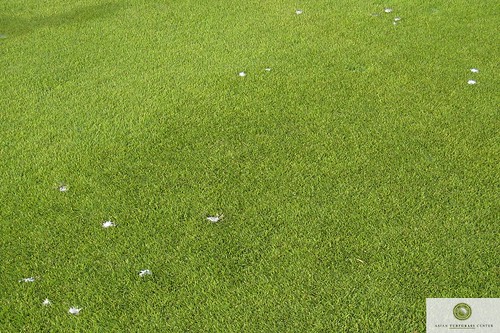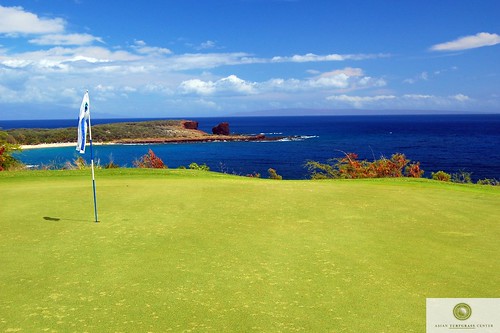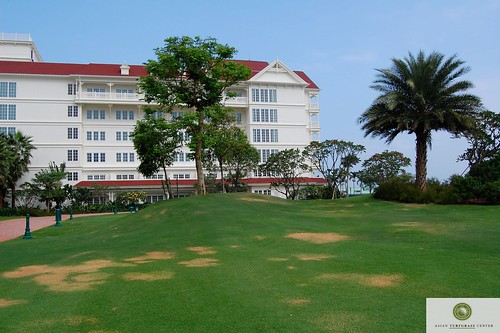
This disease has recently been confirmed as dollar spot in South China and in my experience with disease occurrence and control throughout Southeast Asia, dollar spot is the primary disease infecting seashore paspalum turf.
There is something else that can look a lot like dollar spot on seashore paspalum turf, but is not. I have seen this at Dubai, Hawaii (sorry for straying out of the international region!), Hong Kong, and Thailand. At Dubai in the photo below, on a seashore paspalum tee, this has the appearance of dollar spot mycelium, or perhaps even pythium.
At Hawaii, on a seashore paspalum green, you can see similar symptoms that appear very much like dollar spot: bleached leaves, thinned foliage in the spots, each spot approximately the size of a silver dollar coin.
Here is a closer look at an individual spot on the green.
But this is not dollar spot. The photo below shows a seashore paspalum lawn at Hong Kong Disneyland, and the bleached spots are much larger than what we would see from dollar spot. These are clearly patches of damaged turf, not spots.
What is causing the symptoms that look like dollar spot at Dubai and Hawaii? What is causing the patches of bleached turf at Hong Kong? I'm sure someone will quickly give the answer. Please leave your answer in the comments section of this post or at the Turf Diseases Facebook page.
There is something else that can look a lot like dollar spot on seashore paspalum turf, but is not. I have seen this at Dubai, Hawaii (sorry for straying out of the international region!), Hong Kong, and Thailand. At Dubai in the photo below, on a seashore paspalum tee, this has the appearance of dollar spot mycelium, or perhaps even pythium.
At Hawaii, on a seashore paspalum green, you can see similar symptoms that appear very much like dollar spot: bleached leaves, thinned foliage in the spots, each spot approximately the size of a silver dollar coin.
Here is a closer look at an individual spot on the green.
But this is not dollar spot. The photo below shows a seashore paspalum lawn at Hong Kong Disneyland, and the bleached spots are much larger than what we would see from dollar spot. These are clearly patches of damaged turf, not spots.
What is causing the symptoms that look like dollar spot at Dubai and Hawaii? What is causing the patches of bleached turf at Hong Kong? I'm sure someone will quickly give the answer. Please leave your answer in the comments section of this post or at the Turf Diseases Facebook page.






















3 Responses to “More About Seashore Paspalum”
I've seen symptoms that looked like dollar spot that actually were Fusarium when sent to the lab. I have seen this on two courses with paspalum in Florida. The first course with Salam had experienced these symptoms every year starting in November. The symptoms progressively got worse every year throughout winter. This year, upon successful identification, applications of a DMI fungicide cleared up the problem.
Hi Kevin,
Thank you, that is interesting about the Fusarium. In the photos here, the cause of the dollar spot-like symptoms is not Fusarium. In Southeast Asia the seashore paspalum seems to be more susceptible to damage from diseases when the weather is cool and the growth of the grass slows. When it is growing quickly, there are minimal disease problems.
Sorry everyone, this was a bit of a trick question. It is not mycelium and not a fungus causing the discolored turf. Seashore paspalum is quite salt tolerant. These photos (except for the first one) show salt spot applied to weeds at Dubai, goosegrass discolored on a seashore paspalum green at Hawaii, and bermudagrass+nutsedge discolored by salt applications in a seashore paspalum lawn at Hong Kong.
Post a Comment